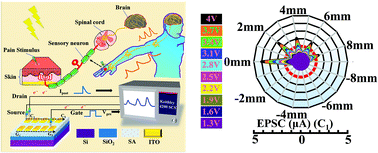A biopolymer-gated ionotronic junctionless oxide transistor array for spatiotemporal pain-perception emulation in nociceptor network†
Abstract
Capable of reflecting the location and intensity of external harmful stimuli, a nociceptor network is of great importance for receiving pain-perception information. However, the hardware-based implementation of a nociceptor network through the use of a transistor array remains a great challenge in the area of brain-inspired neuromorphic applications. Herein, a simple ionotronic junctionless oxide transistor array with pain-perception abilities is successfully realized due to a coplanar-gate proton-coupling effect in sodium alginate biopolymer electrolyte. Several important pain-perception characteristics of nociceptors are emulated, such as a pain threshold, the memory of prior injury, and sensitization behavior due to pathway alterations. In particular, a good graded pain-perception network system has been successfully established through coplanar capacitance and resistance. More importantly, clear polarity reversal of Lorentz-type spatiotemporal pain-perception emulation can be finally realized in our projection-dependent nociceptor network. This work may provide new avenues for bionic medical machines and humanoid robots based on these intriguing pain-perception abilities.

- This article is part of the themed collections: Nanoscale Most Popular 2022 Articles and Nanoscale 2023 Lunar New Year Collection


 Please wait while we load your content...
Please wait while we load your content...